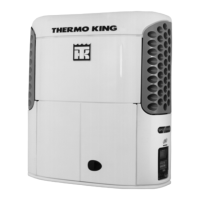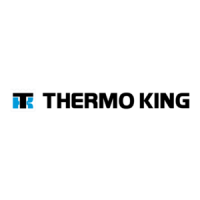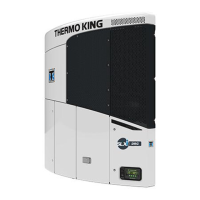Operating Instructions
41
After Start Inspection
After the unit is running, the following items can
be quickly checked to confirm that the unit is
running properly.
1. Oil Pressure: Check the engine oil pressure in
high speed by pressing the
OIL PRESS key. The
oil pressure should read OK, not Low.
2. Ammeter: Check the ammeter reading by
pressing the
AMPS key. The ammeter should
indicate normal battery charging current. It
may be fairly high right after starting the unit,
but should taper off as the battery is recharged.
3. Compressor Oil: The compressor oil level
should be visible in the sight glass.
4. Refrigerant: Check the refrigerant charge. See
“Refrigerant Charge” in the Refrigeration
Maintenance chapter.
5. Pre-cooling: Make sure that the setpoints are
at the desired temperatures and allow the unit
to run for a minimum of 1/2 hour (longer if
possible) before loading the trailer.
This provides a good test of the refrigeration
system while removing residual heat and the
moisture from the trailer interior to prepare it
for a refrigerated load.
6. Defrost: When the unit has finished
pre-cooling the trailer interior, manually
initiate defrost cycles in each compartment.
This will remove the frost that builds up while
running the unit to pre-cool the trailer.
To manually initiate a Defrost cycle, press the
SELECT key until the [dEF] screen appears,
then press the
ENTER key. This will initiate a
Defrost cycle in the compartment for the
active Zone icon. Refer to the appropriate
Microprocessor Diagnosis Manual for more
information about Manual Defrost.
The Defrost cycle should end automatically.
NOTE: An evaporator will not defrost unless
its coil temperature is below 45 F (7 C).
Loading Procedure
1. Make sure the unit is Off before opening the
doors to minimize frost accumulation on the
evaporator coil and heat gain in the trailer.
(Unit may be running when loading the trailer
from a warehouse with door seals).
2. Spot check and record load temperature while
loading. Especially note any off-temperature
product.
3. Load the product so that there is adequate
space for air circulation completely around the
load. DO NOT block the evaporator inlet or
outlet.
4. Products should be pre-cooled before loading.
Thermo King transport refrigeration units are
designed to maintain loads at the temperature
at which they were loaded. Transport
refrigeration units are not designed to pull hot
loads down to temperature.
Single Temperature Loading
Procedures
Additional steps must be taken to insure load
temperature requirements are implemented and
maintained when a multi-temp unit is used to
refrigerate a single-temperature load.
Figure 15: Single Temperature Load, Host On and
Remote Off, Bulkhead Open/Removed
It is strongly recommended that if the whole load
is to be maintained at the same temperature, then
all bulkhead doors should be stowed in the open
position (or, ideally, removed altogether), the host
unit set to operate on its own and the remote
evaporator(s) switched off. This will provide the
best solution if the host units capacity is designed
to cool the complete trailer.
NOTE: If the bulkheads are removed, a
multi-temp unit may not have the cooling or
heating capacity to maintain a specific
temperature range throughout an entire trailer.
AJA1222

